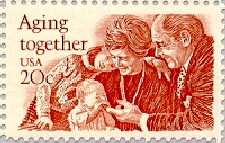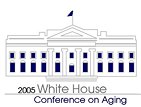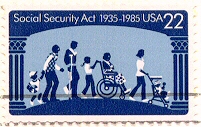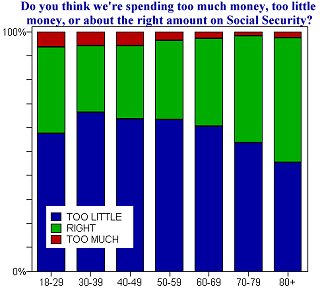POLITICS OF AGING:
GOVERNMENT AGENCIES AND THE AGING NETWORK
The new class war between the young and the old will manifest itself
in several ways. First, there will be heavy pension taxes that may eventually
absorb more than one-fourth of the income of both workers and employers.
This new class war may progress so far that we will see workers and employers
standing shoulder to shoulder against the hard- driven politicians who
promise our senior citizens impossible pensions and encourage the older
worker to exploit the younger worker, the older farmer to exploit the younger
farmer, the older businessman ..., the older professional man ... Let us
remember that these pension leaders will soon have the votes. Karl Marx
and others have taught us that mass movements are rarely rational: they
spring from broad social changes. These basic changes in the population
pattern started recently and slowly; the resulting mass movement has not
yet matured. Townsendism may be as
important in the next fifty years as
were the doctrines of Karl Marx during the last half century.
--F.G. Dickinson, in report to the
First Annual Southern
Conference on Gerontology, 1951
Has Dickinson's prophecy come to be? In Jagadeesh Gokhale and Laurence Kotlikoff's
"Is War Between
Generations Inevitable" they note how in 2001 a 65-year-old female can expect to receive $163,000 more in
government transfer payments (e.g., Social Security, Medicare, Medicaid, and other state and federal welfare
entitlements) than she will pay in taxes. A 20-year-old female, on the other hand, can expect
to pay $92,000 more in taxes. Further, these two practitioners of the new
discipline of "generational accounting" observe that while "an
American born today can expect to pay 17.7 percent of his or her income over and
above any transfer benefits he will receive," tomorrow's newborn can expect
to pay 35.8%.
 Former British Minister of Health, Ian Macleod, wrote that "in
the capitalist democracies, the ageing of the population has raised new
difficulties. It is the `Mount Everest' of the present day social problems."
"Not only are there many more aged people than there were," wrote
Simone de Beauvoir in The Coming of Age, "but they no longer spontaneously integrate with
the community: society is compelled to decide upon their status, and the
decision can only be taken at the government level. Old age has become
the object of policy."
Former British Minister of Health, Ian Macleod, wrote that "in
the capitalist democracies, the ageing of the population has raised new
difficulties. It is the `Mount Everest' of the present day social problems."
"Not only are there many more aged people than there were," wrote
Simone de Beauvoir in The Coming of Age, "but they no longer spontaneously integrate with
the community: society is compelled to decide upon their status, and the
decision can only be taken at the government level. Old age has become
the object of policy."
Consider what is, in effect, the Bill of Rights for the Old, Title
I of the 1965 Older
Americans Act:
- An adequate income in retirement in accordance with the American
standard of living.
- The best possible physical and mental health which science can make
available and without regard to economic status.
- Suitable housing, independently selected, designed and located with
reference to special needs and available at costs which older citizens
can afford.
- Full restorative services for those who require institutional care.
- Opportunity for employment with no discriminatory personnel practices
because of age.
- Retirement in health, honor, and dignity--after years of contribution
to the economy.
- Pursuit of meaningful activity within the widest range of civic,
cultural, and recreational opportunities.
- Efficient community services which provide social assistance in
a coordinated manner and which are readily available when needed.
- Immediate benefit from proven research knowledge which can sustain
and improve health and happiness.
- Freedom, independence, and the free exercise of individual initiative
in planning, and managing their own lives.
(U.S. Annotated Code, Title 42)
Do you know of any other age groups with such entitlements?! Whereas
in 1992 some 46% of all federal domestic spending went to the elderly,
only 11% went to children. Click here to examine this
share of federal expenditures going to older Americans in 1995. In
2001, 6.7% of America's GDP went to Social Security and Medicare (at a time when
government spending was about 20%); projections are that in 2030 this will rise
to 11.1%. Among the
consequences of
this legislation was the creation of the "aging network," including
state agencies on aging and
area agencies on aging, the abolition of most
mandatory retirement age limits, meals-on-wheels, and numerous oversight and referral
services. Click here for the 2006 Amendments to the Older Americans Act.
Over the past quarter century, as the proportion of older persons
living in poverty has declined, that of children has increased. Click here
to see longitudinal poverty rates of the young and
old. See also "Living Younger
Longer" from the 2005 White House Conference on Aging (Oct. 1, 2004).
- Robert
Hudson's "Political Science Perspectives on Aging Policy"
THE VOTING CLOUT OF OLDER
AMERICANS
Americans over 60 years of age vote with a vengeance and constitute a formidable
bloc (see Casey Mulligan & Xavier Sali-i-Martin's "Gerontocracy,
Retirement, and Social Security" [pdf format]). They have a vested
interest in the political allocations: in 2002, Social Security and Medicare had
roughly 40 million beneficiaries. According to the New York Times's "Portrait of the 1996 Electorate," those sixty and older
cast 24 percent of the total vote. This political clout will only increase as more educated
cohorts enter into their sixties and seventies. In 1986, according to the Census Bureau, for the
first time since 18-year-olds won the right to vote in 1972, America's youngest voters (those
18-24) were outnumbered by the elderly. Ten years later, those 18 to 29 cast but 17 percent of
the total vote.
PERCENT HAVING VOTED (IF WAS ELIGIBLE TO DO SO)
IN LAST PRESIDENTIAL ELECTION
BY AGE AND EDUCATION (COMBINED 1973-94 NORC GSS)
|
0-11 YRS |
HS GRAD |
SOME POST-
SECONDARY |
4+ YEARS
COLLEGE |
TOTAL |
| 18-29 |
22 |
42 |
62 |
74 |
51% |
| 30-39 |
38 |
61 |
73 |
85 |
66% |
| 40-49 |
53 |
74 |
82 |
91 |
75% |
| 50-59 |
64 |
83 |
89 |
94 |
80% |
| 60-69 |
69 |
87 |
90 |
95 |
81% |
| 70-79 |
74 |
88 |
91 |
93 |
81% |
| 80+ |
70 |
83 |
87 |
95 |
77% |
| TOTAL |
58% |
68% |
76% |
86% |
|
So can older voters really be perceived as a voting bloc? Only if matters directly
affect them. You will note from the New York
Times's "Portrait of the 1996 Electorate" that older persons' votes generally have
over the past seven Presidential elections been distributed among candidates in about the same
proportions as have those of middle-aged and younger persons. The notable exceptions were in
1988, when they were significantly more likely than others to go for Dukakis, and in 1992,
when they were significantly less likely to vote for Perot.

Will age- or generationally-based politics ultimately replace in the 21st
century the race- and ethnically-based politics of the 20th? Given the
immigration wave of the 1980s and 1990s, it may well be the case that
age-dynamics will only amplify the politics of the past, especially as the old
will be disproportionately Anglo and the young will be disproportionately
comprised of Hispanic and Asian Americans. For one prognostication of the
forthcoming impacts of aging Boomers on the political order see Peter Keating's
"Wake-Up
Call" (AARP: The Magazine, September & October, 2004).
FEDERAL SERVICES AND RESOURCES

- Administration on
Aging
- U.S. Senate Special Committee on Aging
- The National Aging Information
Center

- National Association of Area Agencies on Aging
- National Institute on Aging
- FirstGov for Seniors
- Jacob Siegel's
"Aging Into the 21st Century" (AoA Report, 1996)
- Department of Veterans Affairs (VA)
Home Page
- Final Report
of the 1995 White House Conference on Aging
SOCIAL SECURITY
There can be little doubt, in light of the President's State of the Union
Address and the debate that it has generated, that Social Security will be one
of the hot political issues of 2005. One decade earlier, Social Security constituted 22 percent of federal spending,
about 46 percent of all of its domestic spending. This program takes more
money out of Americans' paychecks than does the federal income tax for
nearly four out of ten American taxpayers (Click here to see how maximum
taxable earnings and tax rates have changed since 1937). It is a regressive tax. (Made
over $200,000 last year? Lucky you! You only have have to pay Social Security
taxes on $87,900.) As will be developed below, built into the program is a system of
"generational inequity,"
which has been likened to a huge Ponzi or pyramid scheme with
payoffs proportional to how early individuals entered the game. It also has built-in class and
racial inequities: life expectancy of the black male is barely more than the "magic
age" of 65 at which time males can now retire with full benefits.

The first national social security program was implemented in 1883
by German Chancellor Otto von Bismarck, who, we should note, established
that "magic age" of 65 at a time when life expectancy at birth
was about 37 years. Bismarck's motivations were not so much humanitarian
but politically motivated: the masses had to be weaned away from socialism,
just as was the case sixty years later when FDR penned this country's program
into law (see the SSA's version of
its own history here). When Social Security began, only 54% of all men
and 62% of all woman lived until 65; those who did make it that far could
expect to live another 12.8 years. By 1990, 72% of all men and 84% of all
women could expect to live until 65, and those who live that age in 1982
could expect to live more than 16 years.
Of all federal programs, Social Security has had an undeniable effect
on the poverty rate of the oldest segment of the population. The poverty
rate for those sixty-five and older fell from 35 percent in 1959 to 25
percent in 1970 to a 1989 low point of 11 percent. Demographics contributed to the success of
this program that redistributes income from younger to older generations--and will contribute to
its demise: in 1950, there were 16.5 workers per each beneficiary; by 1990, this ratio had
declined to 3.3. By 2020, when most boomers will have entered into their seventies and eights,
this ratio has been projected to be about 2.4.
Indeed, for early cohorts of older Americans, Social Security proved to be a great
deal. Take, for instance, the case of Ms. Ida Fuller, recipient of the nation's first Social
Security check, numbered 00-000-001, in 1940. She lived to the ripe old age of 100 and, for
her $24.75 contribution in employee taxes, collected for than $20,000 in benefits. In
Borrowed Time, Peter G. Peterson and Neil Howe describe how a man born in
1916, who began working at age 21, and who earned the average wages in Social Security-
covered employment throughout his career. He retires in 1981 at age 65, and with his 65-year-
old nonworking wife will receive, assuming average life-expectancy, some $178,000 in Social
Security and Health Insurance. Still not a bad return on the $39,000 he paid in payroll taxes!
The authors go on to note how this couple would have been reimbursed for all their Social
Security payments plus interest within their first three and one-half years of retirement, and
how, after six and one-half years, they would have been reimbursed for all of their federal
income taxes as well. But such returns are not in the cards for the post-war generations. In the
mid-nineties, an often-reported statistic was how
more young Americans believed in UFOs than
in the likelihood of their receiving Social Security when they retire.
According to George Church and Richard Lacayo ("Social
(In)Security,"
Time, March 20, 1995:24-32):
- In 1995, a time when those numerous Boomers were hitting their earnings peak,
SSA ended up with a surplus of $58 billion.
- This surplus goes into a trust fund (contrary to what 15%
of Americans believe, it doesn't go into personal accounts) where it is
"invested" in Treasury bonds.
- This "investment" is actually an IOU of the federal government,
which spent this $58 billion on such things as military weapons and welfare
checks.
- Check out the bookkeeping: "The government gets to report a
deficit of $193 billion, rather than the $251 billion it would have to
confess to if it did not have the use of that Social Security money. At
the same time, the Social Security trust fund shows an increase of $58
billion in the money it supposedly has stashed away to pay future pensions."
- When the crunch comes and money paid out exceeds that which is taken
in, the Treasury bonds must be converted to cover payments. To do this
the federal government has several grim choices: raise federal taxes, raise
Social Security taxes (which have already been raised ten-fold over the
past 45 years), slash pensions, or just print more currency (how do you
spell I-N-F-L-A-T-I-O-N?)
 And how do Americans view this program and its effect on aged poverty?
According to The Washington Post/Kaiser Family Foundation/Harvard
University Survey Project's "Why Don't Americans Trust the Government?"
survey of late 1995 (n=1,514 adults 18 and older), when asked "Compared
with 20 years ago, do you think the share of Americans over 65 who live
in poverty has increased, decreased or stayed about the same?" some 59%
believed that it had increased (and only 15% saw a decrease). And when asked about
"what effect, if any, do you think the federal government's [old age] programs have had
on the share of Americans over 65 who live in poverty", only 23 percent thought that
they have "helped make things better" while 32 percent thought they have
"made things worse" and 39 percent seeing not "much effect either
way." According to the combined 2000-2002 NORC General Social Surveys of American adults
(n=5,297), as can be seen in the graph on the right, belief that we're spending too little on Social
Security generally decreases with age, from 66% of those in their thirties to
45% of those eighty and older.
And how do Americans view this program and its effect on aged poverty?
According to The Washington Post/Kaiser Family Foundation/Harvard
University Survey Project's "Why Don't Americans Trust the Government?"
survey of late 1995 (n=1,514 adults 18 and older), when asked "Compared
with 20 years ago, do you think the share of Americans over 65 who live
in poverty has increased, decreased or stayed about the same?" some 59%
believed that it had increased (and only 15% saw a decrease). And when asked about
"what effect, if any, do you think the federal government's [old age] programs have had
on the share of Americans over 65 who live in poverty", only 23 percent thought that
they have "helped make things better" while 32 percent thought they have
"made things worse" and 39 percent seeing not "much effect either
way." According to the combined 2000-2002 NORC General Social Surveys of American adults
(n=5,297), as can be seen in the graph on the right, belief that we're spending too little on Social
Security generally decreases with age, from 66% of those in their thirties to
45% of those eighty and older.
With this level of pluralistic ignorance (which may well have kept a number of
generationally-based social movements from sprouting), reform will be difficult as time begins
running out. According to the Cato
Institute, sometime between 2006 and 2012 Social Security will begin paying out more
than it takes in. In fact, the event transpired in 2010 in the midst of the Great Recession. Among the options being considered is the privatization of the program, with
the Chilean pension system often pointed
to as a model to be emulated. There all but the poorest tenth of workers are required to
put 12% of their salaries into one of twenty-four government-regulated investment funds. With
national savings rate up to 29% (compared to 3% in the United States), that nation's economy
is prospering as are its citizens, whose average net worth is roughly four times their average
salary (compared to a ratio of one in the U.S.). Be sure to check out the positions
favoring and opposing privatization among the groups below.
- "Social Security 75th Anniversary Survey Report: Public Opinion Trends" (2010)
- SSA Home Page, including the
2004 Annual Report of the Board of Trustees of the Federal
Old-Age and Survivors Insurance and Disability Insurance Trust Funds, which claims the trust fund will remain solvent until 2038
- Center on Budget and
Policy Priorities' "How Would Various Social Security Reform Plans Affect Social Security
Benefits? An Analysis of the Congressional Research Service Report"
- Century Foundation's Social Security Network
- Public Agenda's Social Security Study Guide
- Christiane
Roehler's "The Social Security Page"
- Walter M. Cadette, "Social Security Privatization: A Bad Idea" (Policy Notes from the Jerome Levy Economics Institute)
- Christian E.
Weller, "Raising the Retirement Age: The Wrong Direction
for Social Security" (Fall, 2000)
- PizzaEconomics claims that
"privatizers are feeding the American public a lot of misinformation about Social
Security"
- C. Eugene Steurele's
(Urban Institute) "The Simple Arithmetic Driving Social Security Reform"
INTERNATIONAL SOCIAL SECURITY PROGRAMS AND
INITIATIVES
- Social Security
Programs Throughout the World-1997 (pdf format)
- Japan's
Social Security Initiatives (from Japan's Ministry of Foreign Affairs)
- International Labour
Organization's Cost of Social Security--Basic International Tables, 1990-93
MEDICARE/MEDICAID
 Throughout the 1990s, escalating medical costs for older persons sent political
shockwaves throughout Washington. Between 1990 and 1997, Medicare spending had
increased an average of 10% a year. Any threats of spending curtailments
quickly produced powerful opposing social movements. The
Spring of 1993, for instance, saw a group of 20 organizations representing the aged, hospitals and physicians
launch an attack on rumored Senate cuts of as much as $35 billion in Medicare and Medicaid
spending. The House had approved $55 billion in cuts in future Medicare and Medicaid spendings, which over the following five years was projected to be $1.1 trillion just for
Medicare. By the conclusion of the fiscal year ending September 30, 1998, annual
Medicare spending had reached $212 billion. Six years later it was almost
$300 billion.
Throughout the 1990s, escalating medical costs for older persons sent political
shockwaves throughout Washington. Between 1990 and 1997, Medicare spending had
increased an average of 10% a year. Any threats of spending curtailments
quickly produced powerful opposing social movements. The
Spring of 1993, for instance, saw a group of 20 organizations representing the aged, hospitals and physicians
launch an attack on rumored Senate cuts of as much as $35 billion in Medicare and Medicaid
spending. The House had approved $55 billion in cuts in future Medicare and Medicaid spendings, which over the following five years was projected to be $1.1 trillion just for
Medicare. By the conclusion of the fiscal year ending September 30, 1998, annual
Medicare spending had reached $212 billion. Six years later it was almost
$300 billion.
 Not surprisingly, such sums triggered considerable greed. During the 1980s there were reports of
Medicare and Medicaid being billed for patients never seen, for excessive tests, and for
prescriptions never filled. In 1989, a government study by
Richard Kusserow, the inspector general of the Department of Health and Human Services,
found that physicians who own or invest in laboratories prescribed 45% more clinical services
for Medicare patients than did other physicians. Also that year the GAO concluded that over
$10 billion in Medicare funds had been misspent over the previous six years, with Medicare
picking up the tab for payments for which private health plans actually were
liable. In 1997, federal investigators for the Department of Health and Human Services
reported that the government overpaid hospitals, doctors and other health care providers last
year by $23 billion, or 14% of all the money spent in the standard Medicare
program.
Not surprisingly, such sums triggered considerable greed. During the 1980s there were reports of
Medicare and Medicaid being billed for patients never seen, for excessive tests, and for
prescriptions never filled. In 1989, a government study by
Richard Kusserow, the inspector general of the Department of Health and Human Services,
found that physicians who own or invest in laboratories prescribed 45% more clinical services
for Medicare patients than did other physicians. Also that year the GAO concluded that over
$10 billion in Medicare funds had been misspent over the previous six years, with Medicare
picking up the tab for payments for which private health plans actually were
liable. In 1997, federal investigators for the Department of Health and Human Services
reported that the government overpaid hospitals, doctors and other health care providers last
year by $23 billion, or 14% of all the money spent in the standard Medicare
program.
As the 2000 Presidential election heated up the high cost of prescription drugs
and the extent to which Medicare should cover their purchase emerged as key
issues for older persons. Click
here for story of how pharmaceutical companies are battling against
government interventions in their industry.
Fact from the Files: Some 28% of Medicare expenditures are used by 5.9% ultimately
deceased older population. In other words, between one-quarter and one-third
of Medicare monies go to those in their last few months of life.
- Robert B. Helms, "The Origins of Medicare"
- Charlotte Twight, "Medicare's Origin: The Economics and Politics of Dependency"
- Health Care Finance Administration
- Official U.S. Government
Site for Medicare
- Texas Medicaid Reform
Web Server
STATE
AGENCIES
ON AGING
- State of Florida:
Department of Elder Affairs
- Bureau of Maine's
Elder & Adult Services Resource Directory
- North
Central-Flint
Hills Area Agency on Aging; page 1
- Texas Department on
Aging
- Texas Dept.
of Protective and Regulatory Services: Preventing abuse
ADVOCACY
Lobbying groups on behalf of older persons have proliferated in the past two
decades, profoundly shaping federal social policy. The Leadership Council of Aging Organizations
now lists 40 such groups, up from 29 in 1988. They are the latest stage in the history of the
senior movement, which, according to Armond Mauss in Social Problems as Social
Movements, can be typified thusly:

- Incipiency: (1920-49) old-age pension movements, Townsend Movement, Social
Security, founding of National Retired Teachers Association (1947);
- Coalescence: (1950-69) National Council On the Aging founded (1950),
American Association of Retired Persons founded, 1961 White House Conference on Aging,
Senate Special Committee on Aging (1961), NCSC founded in 1961, Medicare, Older
Americans Act (1965), establishment of Administration on Aging;
- Institutionalization: Gray Panthers founded (1970), 1971 White House
Conference on Aging, 1972 Social Security Amendments, House Select Committee on Aging
(1974), National Institution on Aging (1974);
- Fragmentation
- Demise: abolition of Congressional select committees on aging?
The Townsend Movement is a fascinating chapter in this history. In the early
thirties amidst the Great
Depression, Francis Townsend, a California physician, had an economic model for
getting America out of its plight involving the velocity of money: the government would give
$200 a month (or, according to my calculations, $2,339 in 1997
dollars) to all individuals over the age of 60, who, in turn, would be required to spend it.
Needless to say, with over one-half of the nation's old living in poverty, the popularity of this
idea was considerable. Over five million older persons joined Townsend clubs around the
country. The number of these clubs varied considerable across
the states, ranging from nearly 38 clubs per 100,000 people in Oregon to .58 club in
South Carolina. What state level indicators predictors were associated with the popularity of
this movement? Interestingly, not the percentage of the population over 65. Among the factors
we found were (with Pearsons r): 1924 membership in the International Workers of the World
(.53), high male/female sex ratio in 1940 (.69), high rates of home ownership (.62) and the
proportion of workers in the professions (.66), and sizable Scandinavian populations (e.g.,
%Swedish=.46).





-
FirstGov for Seniors--a government portal just for older Americans
- Alliance for Aging Research--non-profit advocacy
group promoting the acceleration of geriatric research
- The
National Council on the Aging
- Elder
Abuse Prevention
GERONTOCRACIES
If there were no old men, there would
be no civilized states at all.
--Cicero
Give me a staff of honour for mine age. But not a sceptre to control the world.
--Shakespeare
Gerontocracies, or rule by the old, have received mixed
reviews throughout history.
In 44 B.C., Cicero argued how "Old men...as they
become less capable of physical exertion, should redouble their intellectual
activity, and their principal occupation should be to assist the young, their
friends, and above all their country with their wisdom and sagacity."
But with industrialization and modernization, elder
veneration decayed as did the notion of elder wisdom. In the final
quarter of the 20th century, the aging of the "founding fathers" of
Russia and China (who seemed reluctant to entrust power to younger generations
who did not know life before the revolution) came to be viewed as obstacles to
change. In the United States, there were stories of President Reagan
dozing during cabinet meetings and in his meeting with the Pope. At
century's turn, there were less
than flattering stories of nonagenarian Strom Thurmond and octogenarians
Henry Hyde, Jesse Helms and Robert Byrd. One wonders what the relationship
is between the age structure of Congress and the number of long-term goals it
establishes. For a particularly harsh indictment against older rulers see
"Conditions
Affecting the Sway of Custom" in Edward A. Ross's 1919 Social
Psychology.
THE OLD AS MINERS' CANARIES--BIOLOGICALLY, POLITICALLY AND SOCIOLOGICALLY
With their diminished biological resources, changes in the mortality rate
of elderly persons are often used as gauges of environmental change. How
hot was it? Over twenty of the city's older population died of
heat-related maladies. Flu season was harsh this year. Thirty-three
elderly members of the community have succumbed to the epidemic since New Years.
This indicator status of older persons also is a measure of societal "well-being."
Neighborhood victimization of elderly residents by young punks is a diagnosis of
sociological cancer--as those who should be accorded esteem for their years of
social contribution (and because they are most likely to know their attackers by
virtue of the correlation between length of residency and the number of one's
social contacts: "Officer, I believe one of them was Lillian's
grandson") are, because of their greater vulnerability, victimized.
Another measure of social
rot, one employed by Amnesty
International: the "humiliation of elderly people."

 Return
to Social Gerontology Index
Return
to Social Gerontology Index
 Former British Minister of Health, Ian Macleod, wrote that "in
the capitalist democracies, the ageing of the population has raised new
difficulties. It is the `Mount Everest' of the present day social problems."
"Not only are there many more aged people than there were," wrote
Simone de Beauvoir in The Coming of Age, "but they no longer spontaneously integrate with
the community: society is compelled to decide upon their status, and the
decision can only be taken at the government level. Old age has become
the object of policy."
Former British Minister of Health, Ian Macleod, wrote that "in
the capitalist democracies, the ageing of the population has raised new
difficulties. It is the `Mount Everest' of the present day social problems."
"Not only are there many more aged people than there were," wrote
Simone de Beauvoir in The Coming of Age, "but they no longer spontaneously integrate with
the community: society is compelled to decide upon their status, and the
decision can only be taken at the government level. Old age has become
the object of policy."


 And how do Americans view this program and its effect on aged poverty?
According to The Washington Post/Kaiser Family Foundation/Harvard
University Survey Project's "Why Don't Americans Trust the Government?"
survey of late 1995 (n=1,514 adults 18 and older), when asked "Compared
with 20 years ago, do you think the share of Americans over 65 who live
in poverty has increased, decreased or stayed about the same?" some 59%
believed that it had increased (and only 15% saw a decrease). And when asked about
"what effect, if any, do you think the federal government's [old age] programs have had
on the share of Americans over 65 who live in poverty", only 23 percent thought that
they have "helped make things better" while 32 percent thought they have
"made things worse" and 39 percent seeing not "much effect either
way." According to the combined 2000-2002 NORC General Social Surveys of American adults
(n=5,297), as can be seen in the graph on the right, belief that we're spending too little on Social
Security generally decreases with age, from 66% of those in their thirties to
45% of those eighty and older.
And how do Americans view this program and its effect on aged poverty?
According to The Washington Post/Kaiser Family Foundation/Harvard
University Survey Project's "Why Don't Americans Trust the Government?"
survey of late 1995 (n=1,514 adults 18 and older), when asked "Compared
with 20 years ago, do you think the share of Americans over 65 who live
in poverty has increased, decreased or stayed about the same?" some 59%
believed that it had increased (and only 15% saw a decrease). And when asked about
"what effect, if any, do you think the federal government's [old age] programs have had
on the share of Americans over 65 who live in poverty", only 23 percent thought that
they have "helped make things better" while 32 percent thought they have
"made things worse" and 39 percent seeing not "much effect either
way." According to the combined 2000-2002 NORC General Social Surveys of American adults
(n=5,297), as can be seen in the graph on the right, belief that we're spending too little on Social
Security generally decreases with age, from 66% of those in their thirties to
45% of those eighty and older. 







